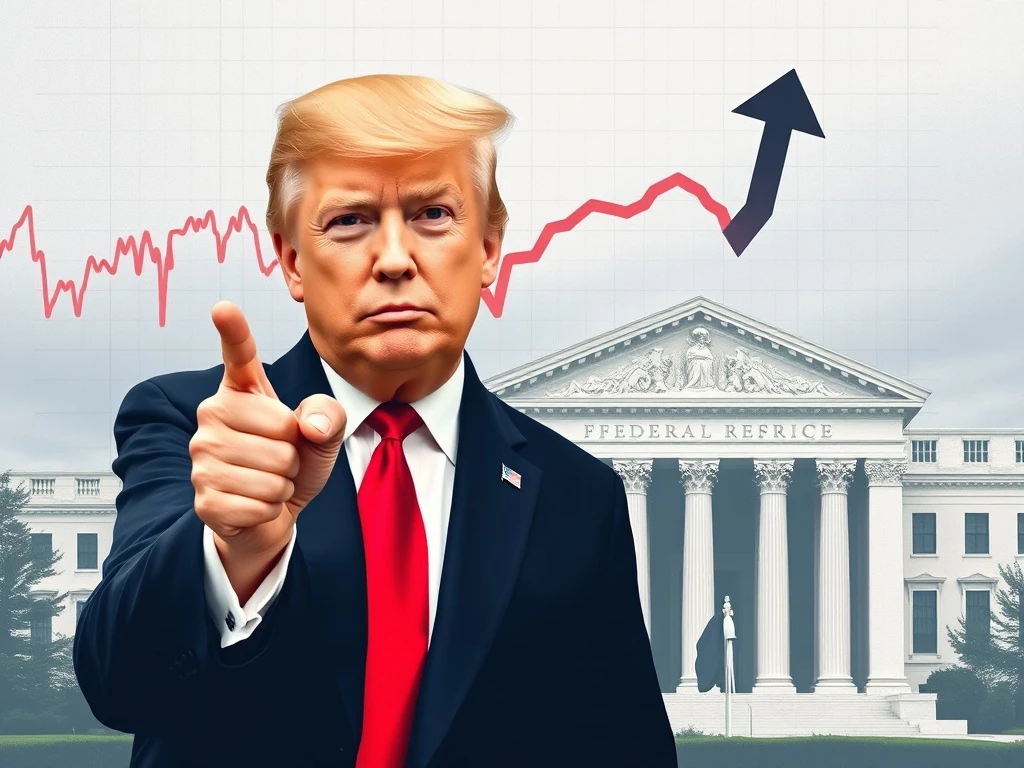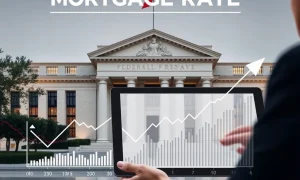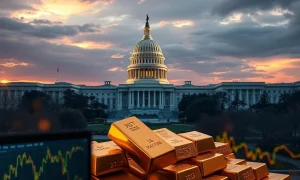The economic landscape often generates complex questions. One such question frequently arose during President Trump’s administration: “Why did he want a **Trump rate cut** so intensely?” Many observers expressed confusion regarding his vocal demands for the Federal Reserve to lower interest rates. This article explores the core reasons behind President Trump’s consistent advocacy for a rate cut. We will examine the economic principles involved and the broader implications of such presidential pressure on an independent central bank. Ultimately, understanding his motivations provides insight into a significant period of U.S. economic policy.
Understanding the Federal Reserve’s Critical Role
To grasp President Trump’s perspective, we must first understand the **Federal Reserve**. The Fed acts as the central bank of the United States. Its primary responsibility involves managing the nation’s monetary policy. This includes setting the federal funds rate, a key interest rate. Furthermore, this rate influences other borrowing costs across the economy. The Federal Reserve operates with a dual mandate. It aims to achieve both maximum employment and stable prices (low inflation). Therefore, its decisions significantly impact economic activity. For instance, lower interest rates typically encourage borrowing and spending, stimulating growth. Conversely, higher rates can curb inflation by slowing down economic activity.
The Fed’s independence from political influence is a cornerstone of its structure. This independence allows it to make decisions based purely on economic data and its dual mandate. Political pressure, however, can sometimes test this independence. Historically, presidents have avoided publicly commenting on Fed policy. President Trump, however, broke with this tradition. He frequently and openly criticized the Fed’s decisions, particularly its rate hikes. He consistently argued for a **Trump rate cut**, believing it was essential for the economy.
The President’s Perspective: Why Trump Demanded a Rate Cut
President Trump’s demands for a **Trump rate cut** stemmed from several key economic and political considerations. He believed lower interest rates would provide significant benefits to the U.S. economy. His arguments were often straightforward and focused on immediate economic indicators. Consequently, his public statements reflected a clear desire for monetary easing. Let’s explore his main reasons:
- Stimulating Economic Growth: President Trump frequently argued that lower rates would accelerate economic growth. He believed cheaper borrowing costs would encourage businesses to invest more. Moreover, consumers would spend more. This, in turn, would lead to increased hiring and overall prosperity. He often pointed to strong employment numbers as evidence of a robust economy. He felt lower rates would only enhance this positive trend.
- Weakening the Dollar: A lower interest rate environment typically leads to a weaker U.S. dollar. A weaker dollar makes American exports more competitive globally. It also makes imports more expensive. This could help narrow the trade deficit, a key focus for President Trump. He believed this would benefit American manufacturers and workers. Furthermore, it could counteract the impact of his imposed tariffs.
- International Competitiveness: Many other central banks globally were cutting rates or maintaining very low rates. President Trump often cited this fact. He argued that the U.S. was at a disadvantage by not following suit. He believed that higher U.S. rates attracted foreign capital, strengthening the dollar. This made American goods less competitive abroad. Therefore, a **Trump rate cut** would level the playing field.
- Boosting the Stock Market: The stock market was a significant barometer for President Trump. Lower interest rates generally make stocks more attractive compared to bonds. This can lead to higher stock valuations. A rising stock market was often highlighted by the President as a sign of economic success. He viewed the Fed’s rate hikes as a hindrance to this growth.
- Reducing Government Borrowing Costs: The U.S. national debt is substantial. Lower interest rates reduce the cost of servicing this debt. This saves taxpayer money. It also provides more fiscal flexibility. This was another practical reason for his desire for a **Trump rate cut**.
The Disconnect: Presidential Pressure vs. Fed Independence
The tension between President Trump and the Federal Reserve, particularly Chairman Jerome Powell, was widely publicized. President Trump appointed Powell. However, he quickly grew critical of Powell’s decisions to raise interest rates. This public criticism raised questions about the Fed’s cherished independence. Many economists and policymakers consider this independence vital. It allows the Fed to make tough, long-term decisions. These decisions might be unpopular in the short term but beneficial for the economy. Without independence, the Fed could face pressure to prioritize political cycles over economic stability. For example, a president might push for rate cuts before an election. This could boost short-term growth but risk inflation later.
The Federal Reserve Act of 1913 established the Fed. It aimed to insulate monetary policy from partisan politics. This design prevents a president from dictating interest rate policy. Instead, the Federal Open Market Committee (FOMC) makes these decisions. The FOMC comprises Fed governors and regional bank presidents. They base their decisions on economic data, forecasts, and their dual mandate. President Trump’s strong calls for a **Trump rate cut** challenged this traditional separation of powers. This created an unusual dynamic between the White House and the central bank. It also sparked considerable debate among financial experts.
Economic Arguments Against Aggressive Rate Cuts
While President Trump strongly advocated for a **Trump rate cut**, many economists presented counterarguments. They highlighted potential risks associated with aggressive monetary easing. These concerns centered on long-term economic stability. Furthermore, they emphasized the delicate balance the Fed must maintain. Therefore, simply cutting rates without careful consideration could lead to unintended negative consequences. Let’s examine some of these opposing viewpoints:
- Inflation Risk: One major concern is the risk of inflation. Cutting interest rates too much can overheat the economy. When money is too cheap, demand can outpace supply. This pushes prices higher. The Fed’s mandate includes price stability. Therefore, it must avoid runaway inflation. Aggressive rate cuts could undermine this crucial objective.
- Asset Bubbles: Artificially low interest rates can inflate asset prices. This includes stocks, bonds, and real estate. Investors may take on more risk in search of higher returns. This can lead to asset bubbles. These bubbles can burst, causing significant economic downturns. The 2008 financial crisis serves as a stark reminder of this danger.
- Limited Policy Tools: If interest rates are already very low, the Fed has less room to maneuver. In a future economic downturn, it would have fewer tools available. Cutting rates is a primary response to recessions. If rates are near zero, other, less conventional tools become necessary. These tools might be less effective or carry their own risks.
- Impact on Savers: Low interest rates negatively impact savers. People relying on interest income from savings accounts or fixed-income investments see their returns diminish. This can reduce their purchasing power. It also affects their retirement planning. This aspect is often overlooked in discussions about stimulating growth.
The Impact of Trump’s Rate Cut Advocacy
President Trump’s persistent advocacy for a **Trump rate cut** undoubtedly influenced the economic discourse. It also created a unique political environment for the Federal Reserve. While the Fed maintained its independence, it did eventually lower rates. These cuts, however, were typically justified by evolving economic data and global uncertainties. For instance, concerns about slowing global growth and trade tensions played a significant role. The Fed’s public statements consistently emphasized data-driven decisions. They did not cite presidential pressure as a factor. Nevertheless, the constant public commentary from the White House was unprecedented. It kept the spotlight on monetary policy. This also fueled market speculation. Investors closely watched every Fed meeting for signs of policy shifts. They also reacted to presidential tweets. The long-term implications for Fed independence remain a subject of debate. Some argue it eroded public trust in the Fed’s autonomy. Others contend the Fed’s steadfast adherence to its mandate proved its resilience. Ultimately, the period highlighted the delicate balance between political desires and independent economic stewardship. The **Trump rate cut** narrative became a defining feature of his economic policy approach.
In conclusion, President Trump’s fervent desire for a **Trump rate cut** was driven by a belief that lower interest rates would propel the U.S. economy to even greater heights. He saw it as a tool for increased growth, a stronger stock market, and improved international competitiveness. However, the Federal Reserve operates under a different mandate. Its decisions are based on economic data and a commitment to price stability and maximum employment. This often led to a public disagreement. The period underscored the critical importance of central bank independence. It also highlighted the complex interplay between political ambition and sound monetary policy. Understanding these dynamics is crucial for comprehending modern economic governance.
Frequently Asked Questions (FAQs)
Q1: What is the Federal Reserve’s primary goal when setting interest rates?
The Federal Reserve has a dual mandate: to achieve maximum employment and maintain stable prices (low inflation). Its interest rate decisions are aimed at fulfilling these two objectives, balancing economic growth with price stability.
Q2: Why did President Trump believe a rate cut would help the economy?
President Trump believed a **Trump rate cut** would stimulate economic growth by making borrowing cheaper for businesses and consumers, thereby encouraging investment and spending. He also thought it would weaken the dollar, boosting U.S. exports and making American goods more competitive globally.
Q3: Is the Federal Reserve truly independent from political influence?
Yes, the Federal Reserve is designed to be independent of political influence. This independence allows it to make monetary policy decisions based on economic data and its dual mandate, rather than short-term political pressures or election cycles. However, presidential rhetoric can still create public discussion.
Q4: What are the potential risks of cutting interest rates too aggressively?
Cutting interest rates too aggressively can lead to several risks. These include increased inflation, the formation of asset bubbles (e.g., in stock or housing markets), and leaving the central bank with limited tools to combat future economic downturns if rates are already near zero.
Q5: Did the Federal Reserve ultimately cut rates during Trump’s presidency?
Yes, the Federal Reserve did cut interest rates during President Trump’s term. However, the Fed consistently stated that these decisions were based on evolving economic data, global economic uncertainties, and trade tensions, rather than direct political pressure from the White House.
Q6: How does a weaker dollar impact the U.S. economy?
A weaker dollar makes U.S. exports more affordable for foreign buyers, potentially boosting export volumes and supporting domestic industries. Conversely, it makes imports more expensive for U.S. consumers and businesses, which can contribute to inflation but also encourages domestic production.








